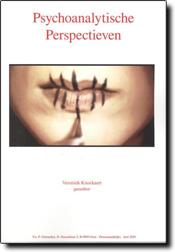Issue: Vol. 28 (1/2) 2010
 Content
Content
Editoriaal
Veroniek Knockaert
Een open brief in een gesloten omslag
Wim Galle
Het vreemde en de instelling
Een brief aan de vreemdeling van Camus
Jeroen Donckers
Het genot van een fascist.
Kritische beschouwingen bij Frank Vande Veires fascismedefinitie
Marc De Kesel
Wilde kinderen, wilde taaltheorieën
Lacans visie op de betekenaar aan de hand van Kaspar Hauser en Victor de l’Aveyron
Dries Roelandts
Omgaan met agressie binnen de instelling
Slaags raken met mensen voor wie we er proberen te zijn
David Blomme
Il était une fois…
La féminité et la position féminine
Veroniek Knockaert
Ethiek in tijden van normen en waarden
Over de mogelijkheid van een ethiek van het reële
François Levrau
Men kan niet Eén worden
Over het lichaam tussen taal en genot
Abe Geldhof
Het raadsel van Kaspar Hauser in de film
“Jeder für sich und Gott gegen Alle” van Werner Herzog
Julien Quackelbeen
La sublimation chez Lacan: destruction créatrice du sujet
Viviana M. Saint-Cyr
Interview “Candy Darling”
Silvia Defrance & Filip Geerardyn
“I don’t stop; I start again.” The position of the analyst in ‘long term care’
From a lacanian orientation, the relation between 'treatment', 'coaching' and 'care' is questioned in case of what one calls 'long term care'. This question is approached from the perspective of a case study. A young man accuses himself constantly of not adapting...
Vampires, Viruses and Verbalisation: Bram Stoker’s Dracula as a genealogical window into fin-de-siècle science
This paper analyses Bram Stoker’s classic Dracula as a literary document which reflects important scientific and technological developments of the fin-the-siècle era, ranging from blood transfusion and virology via psychotherapy and psychoanalysis up to brain research...
Psychoanalysis: a symptomatic problem
In this article the author explores why psychoanalysts are often seen as troublesome people and why they give so much critique. Foucault stated that in modernity the epistèmè changed: ‘man’ came in the thinking frame and human sciences were born. In his opinion...
The Violence of Right: Rereading ‘Why War?’
In this contribution, the often neglected correspondence ‘Why War?’ (Freud, 1933b) is presented as the locus classicus of Freud’s account of ‘Right and Violence’. In the discussion with Freud, Einstein’s position appears in the light of Kant’s Toward Perpetual Peace....
Interview “Candy Darling” Silvia Defrance
Dit gesprek vond plaats op 19 maart 2009 naar aanleiding van de vertoning van Silvia Defrances (2009) film Candy DarZing in FilmPlateau te Gent. Haar film ging een jaar eerder in première en werd sindsdien geselecteerd voor een 40-tal internationale filmfestivals en...
Sublimation in Lacan: The Creative Destruction of the Subject
We will try to demonstrate that the experience of Abbot Suger de Saint-Denis, creator of Gothic architecture, based on the logic of Lacanian sublimation, comes from the elevation of an object to the dignity of the Thing (Lacan, 1986 [1959-1960]: 133). On the one hand,...
The Enigma of Kaspar Hauser in Werner Herzog’s Film “Jeder für sich und Gott gegen alle”
This comment on Werner Herzog's film "Jeder für sich und Gott gegen alle" (1974) deals with the enigma of Kasper Hauser's origins, with the precarious status of the body and with his introduction into language. This is related to the problem of becoming a subject. The...
You cannot become One
The evolution of Lacan's theory of the body in psychosis is presented, starting from his seminar on the sinthome. Some points of rupture can be found retrospectively in Lacan's theory. From his first conceptualization of the imaginary body, then of the symbolic body...
Ethics in a Time of Norms and Values. About the Ethics of the Real
This text aims to clarify the possibility of an ethics of the real. First, we define an ethics of desire, the kind of ethics this article wants to argue against. Next, we highlight the ethics of the real by indicating why the real is a crucial dimension for ethics...
Once upon a Time: Femininity and the Feminine Position
This article has as a central reference Jelinek's revised version of the fairytale "Sleeping Beauty". The author describes how the two protagonists, Sleeping Beauty and her Prince, encounter, take up their positions and mark both relation and difference. Jelinek's...